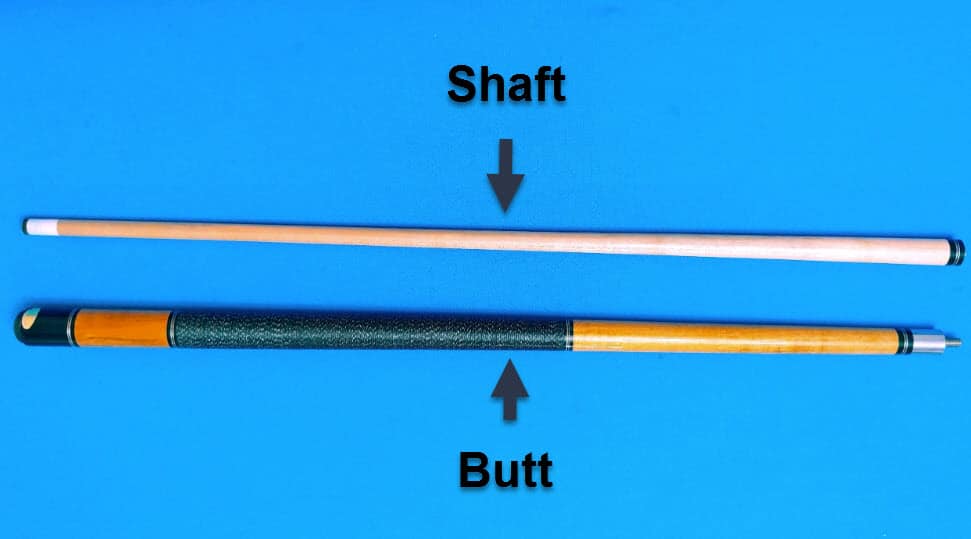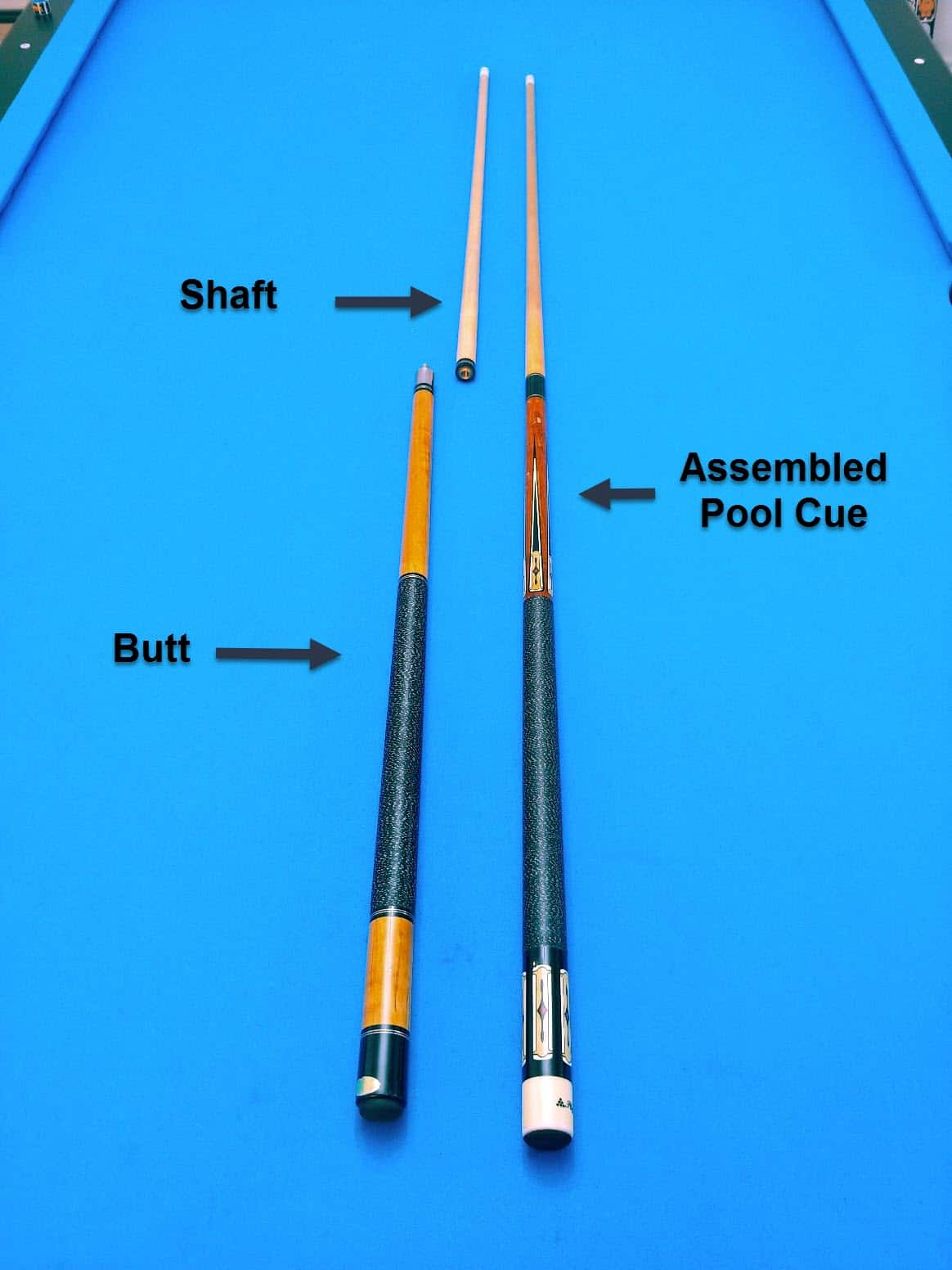What are all the different parts of a pool cue?
A pool cue (pool stick, cue stick, snooker cue or billiards cue) is a stick that players primarily use to strike a ball in games of billiards. Other games that players will use this cue in is also snooker and carom billiards.
The pool cue can easily be broken up into 2 major components that make up a pool cue; the Shaft and the Butt.
As you can see, the Shaft (Top) is the slimmer part of the pool cue while the Butt (Bottom) of the cue is the larger piece of the pool cue.

Here is a picture of pool cue standing straight vertically for reference:

In the image above it is clear that the pool cue butt has the bulk of the weight while the shaft is much lighter.
Pool Cue Shaft

The shaft’s primary role is that the tip of the shaft is the main point of contact which will be striking the cue ball. This is the most important piece out of the two components because it has the most effect on the shot. The shaft is also important because this is the part of the pool cue which a player will rest on their less dominant hand in order to maintain a stable position (If a player is right-handed, they would rest this part of the stick on their left hand).
The shaft component consists of the following:
- Shaft
- Tip
- Ferrule
- Shaft
- Ring
- Collar
- Joint
Each of the terms will be defined further down in the document.
Pool Cue Butt

The pool cue butt is the bottom component where a players hand will grip the pool stick and use it to stroke in order to strike the cue ball (If a player is right-handed, they will grip the pool cue butt with their right hand). Many players will use their old bottom butt and combine it with a newly purchased shaft. This is because, in comparison, the bottom butt doesn’t have as much impact as the shaft because the shaft has the tip and deflection attributes.
The butt component consists of the following:
- Pin
- Ring
- Collar
- Forearm
- Inlays
- Wrap
- Butt Sleeve
- Bumper
Each of these terms will be defined further below.
Pool Cue Shaft in Detail
The shaft has roughly 7 components which each serves a purpose.

Shaft
This is normally made of maple wood but can also be made of fiberglass or graphite. The shaft must be very smooth so that when striking through from the Butt, it is a good sliding transition.
Tip
The tip is the piece that will be contacting the cue ball first. This is held together by glue. The tip hardness varies from “Soft” to “Hard” depending on what the player prefers. The size ranges from 11.75mm to 14mm.
Ferrule
The ferrule is right below the tip and it helps to be the backbone of the tip. It helps prevent further vibration upon impact.
Collar
This is glued to the ring and helps strengthen the pin and makes sure the energy from the butt to the shaft transfers correctly.
Ring
A ring is usually on both the shaft and the butt piece so they are matching and helps further reinforce the join of the cue.
Joint
This is the very bottom piece of the pool shaft where it connects the butt and the shaft. It is normally made of metal, wood, buckhorn, ivory or phenolic resin. There are also joint caps which fit or screw right onto the joint to protect it from damage.
Pool Cue Butt in Detail

The pool cue butt components consist of roughly 8 parts which all serve a purpose too, but in contrast about half of these details are for style preference to the player.
The butt component contains the following:
Pin
The pin is at the very top of the pool cue butt. It is normally metal and it connects the butt to the shaft. It’s normally a wood to wood connection and there is also a joint protect that you can screw to protect this piece too.
Ring
The ring also matches the ring on the top shaft ring and helps reinforce the joints of the cue.
Collar
The collar is located usually right below the pin and is normally steel, wood, ivory or molded phenolic resin. It’s also glued and threaded and helps ensure energy transfer throughout the whole cue.
Forearm
This is normally a style preference of the player and displays a design. This part of the cue can factor into the price point of the pool cue depending on the design.
Inlays
This is another style preference where materials can include ivory, exotic woods or gemstones. The price of the inlays can also vary depending on the player preference.
Wrap
This is normally where a player will handle the cue and is usually Irish linen or leather. It helps the player grip the cue better and helps absorbs moisture.
Butt Sleeve
This is right under the wrap and made separately and cored out for weight balance. Usually matches the forearm.
Bumper
The bumper is located at the very bottom of the pool cue butt. It’s normally rubber and protects the cue from damage. This may or may not screw off in order to adjust weight (dependent on which pool cue is purchased).
Conclusion
A pool cue has many different components and it is important to know each of them. Each component serves its own purpose and may come in handy in case you ever need to service or repair your pool cue. Understanding each component may additionally help the player comprehend the importance of each piece and how it affects the players shot.
If you guys are thinking about purchasing a pool cue, I recommend checking my article about The best pool cues under $100. It’s a great list of good recommendations. I hope this helped you guys to identify the different parts of a pool stick and thanks for reading!

